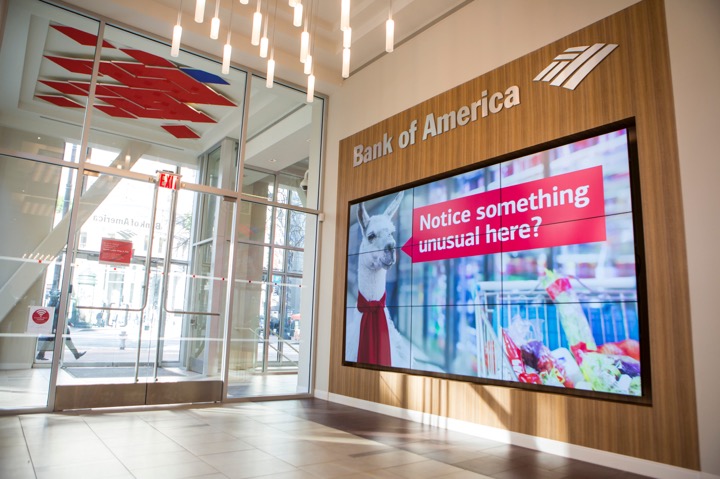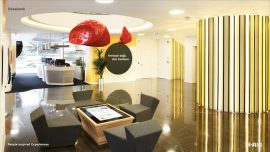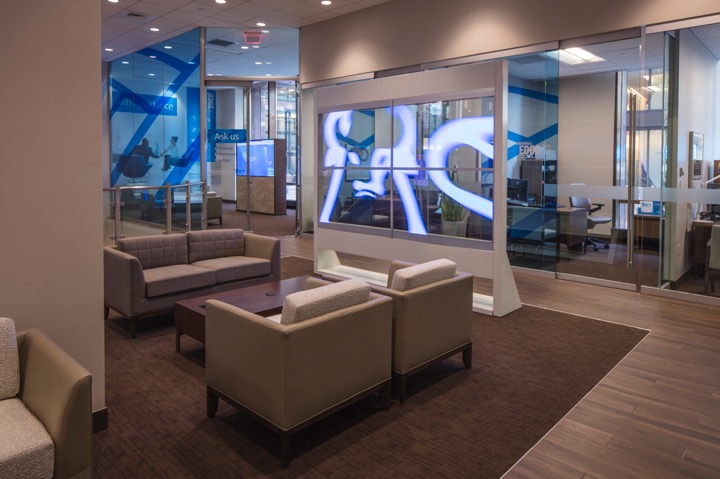For branches, AV technology is money in the bank
Banks around the world are investing in advanced audiovisual technologies to improve customer engagement and reduce overhead.
Brad Grimes, senior director of communications at the Audiovisual and Integrated Experience Association (Avixa), which represents the $178 billion global commercial AV industry, explores.
Modern consumers have more brands and digital activities vying for their attention than ever before. They face a constant barrage of advertisements and social media updates on their mobile devices, resulting in more time spent looking at their screens. Banks have largely adapted, introducing mobile apps for conducting basic transactions, and they are now using digital technology to transform the branch experience and create inviting, purpose-built spaces where customer relationships can be nurtured.
In short, banks have the opportunity to capitalise on the effectiveness of audiovisual (AV) technologies to increase information retention and cross-selling, improve customer relations, reduce visitor frustration, and even improve operational efficiency by reducing real estate and workforce needs.
Doing more with less
Citizens Bank of Rhode Island, a large US retail bank with more than 1,200 branch locations and $5 billion in revenue, offers an example of how banks can adapt to changing consumer habits. In 2018, the bank began a multi-year overhaul that will see many branches shrink their footprint by up to 50%. As part of the project, Citizens Bank is working with AT&T and Cineplex Digital Media Group to outfit all of its branches with new digital signage displays and media players that help maximise customer messaging, improve cross-selling, and engender a community-centre aesthetic by showcasing content customised to the local customer base.
Bruce Van Saun, chairman and CEO of Citizen Financial Group, Inc, says the company-wide initiative includes redesigning many branches to have smaller footprints, with less space dedicated to transactions and more space for private rooms and conversation.
Although some banks have closed branches for financial reasons, Citizens Bank’s strategy represents a different approach with potential benefits, namely that customers can still have the face-to-face interactions they need, but improved utilisation of space and technology can lower costs and boost cross-selling opportunities.
“There’s a little bit of pruning of the number of locations,” Van Saun says, “but the greater element of the program is trying to take 4,200-square-foot branches and turn them into 2,500 or 2,200-square-foot branches. By 2021 we will have gone through 50% of the branches as the target.”
The digital signage displays currently feature topics such as planning for retirement, managing student loans, and community-based activities, while also providing stock indices and local weather and news. According to AT&T, the result is a richer customer experience through next-generation features and new design concepts.
A digital signage display can present far more information than a static advertisement, while using the same amount of physical space. Digital signage offers the ability to present multiple slides, scroll text, switch among promotional subject, and attract attention through changing images or video. In fact, a recent study by Capital Networks found that although static signage impressions drop off dramatically after the first day, digital signage retains a consistent engagement level. In response, banks have begun using adaptive and interactive AV technologies to engage customers and entice non-customers to see what the bank offers.
Creating an interactive storefront
Odeabank entered the Turkish market with a splash of color and outward-facing technology rarely seen in retail bank branches. In Istanbul, the bank’s flagship branch features unique curved architecture and an artful exterior, while the interior utilises a range of audiovisual technologies including large touchscreen tables, tablets, interactive screens, digital signage, room-wide overhead LED tickers, and sophisticated customer tracking that targets its marketing based on visitors’ gender and age.
I-AM, the firm responsible for the flagship store’s architecture and interior design, set out to provide the most efficient and rewarding customer experience, using popular consumer technologies to put guests at ease and provide improved engagement.
Large-scale touchscreen displays in the 24×7 self-service lobby provide interactive applications that allow customers to get loan estimates and information about new products and options, while tabletop touchscreen displays inside the bank can entertain and inform customers. The bright, vibrant design creates excitement, and the constant motion from the digital displays adds to the bank’s energetic environment.
Like Citizens Bank, Odeabank has created more open space and designed its layout to promote customer conversations, while directing common, everyday transactions to ATMs or ITMs (interactive teller machines). The layout gives its digital signage and interactive displays greater reach, as customers move more freely through the branch’s open spaces and spend less time restricted to teller lines and desk pools.
A top-to-bottom videoconferencing experience
For many banks, audiovisual technology upgrades have pervaded the entire corporate environment, bringing new solutions to every level of the company’s operations. Videoconferencing plays a vital role in the daily operations of many corporate offices, reducing travel time and costs, expediting conversations, and helping increase efficiency while also providing more human-centered, face-to-face interaction.
Bank of America has put this audiovisual technology directly in the hands of consumers through its new Advanced Centre, available at select locations. The concept is an employee-free branch featuring an ATM lobby, digital concierge, and private rooms equipped with on-demand videoconferencing systems.
The digital concierge automatically detects a customer’s arrival and instantly connects them to a bank employee located at a call centre for addressing basic banking needs. This provides customers with fast service and a personal feel while using very little floor space.
The private rooms offer videoconferencing with local and national experts to discuss auto loans, mortgages, retirement, and more. With more than 300 Advanced Centre locations currently planned, it is poised to become an important part of the bank’s retail presence.
Dominating the conversation
Still other banks are reaching for the “wow” factor using AV technology. Customers entering Bank of Hawaii’s flagship “Branch of Tomorrow” in Honolulu are greeted with a stunning 10-metre by 2.2-metre LED video wall with a 3mm pixel pitch that results in HD-resolution imagery – the type of technology usually found in stadiums, airports and along major roadways. The video wall, installed by Ford AV, creates a unique experience in the main lobby, displaying captivating Hawaiian scenes interspersed with bank promotions and other marketing campaigns.
Bank of Hawaii is actively advertising its AV technology leadership. On the bank’s website, the company proudly states that its Branch of Tomorrow “offers a 21st-century banking experience – including easy deposit ATMs, wi-fi, tablets, digital screens and a team of financial specialists – to support greater convenience and create personal interactions”.
Digital displays are becoming more ingrained in the everyday lives of nearly every consumer, creating a need for banks to be more proactive in their customer relations and outreach. Increasingly, banking institutions are demonstrating how interactive and multimedia display technologies can enhance the customer experience and revive the sense of community long associated with local bank branches.
Whether the goal is to increase cross-selling, improve the effectiveness of in-branch advertisements, provide information that raises dwell time or reduces visitor frustration, or more efficiently utilise space and workforce, today’s rapidly advancing audiovisual technologies are proving to be the solution.

















































